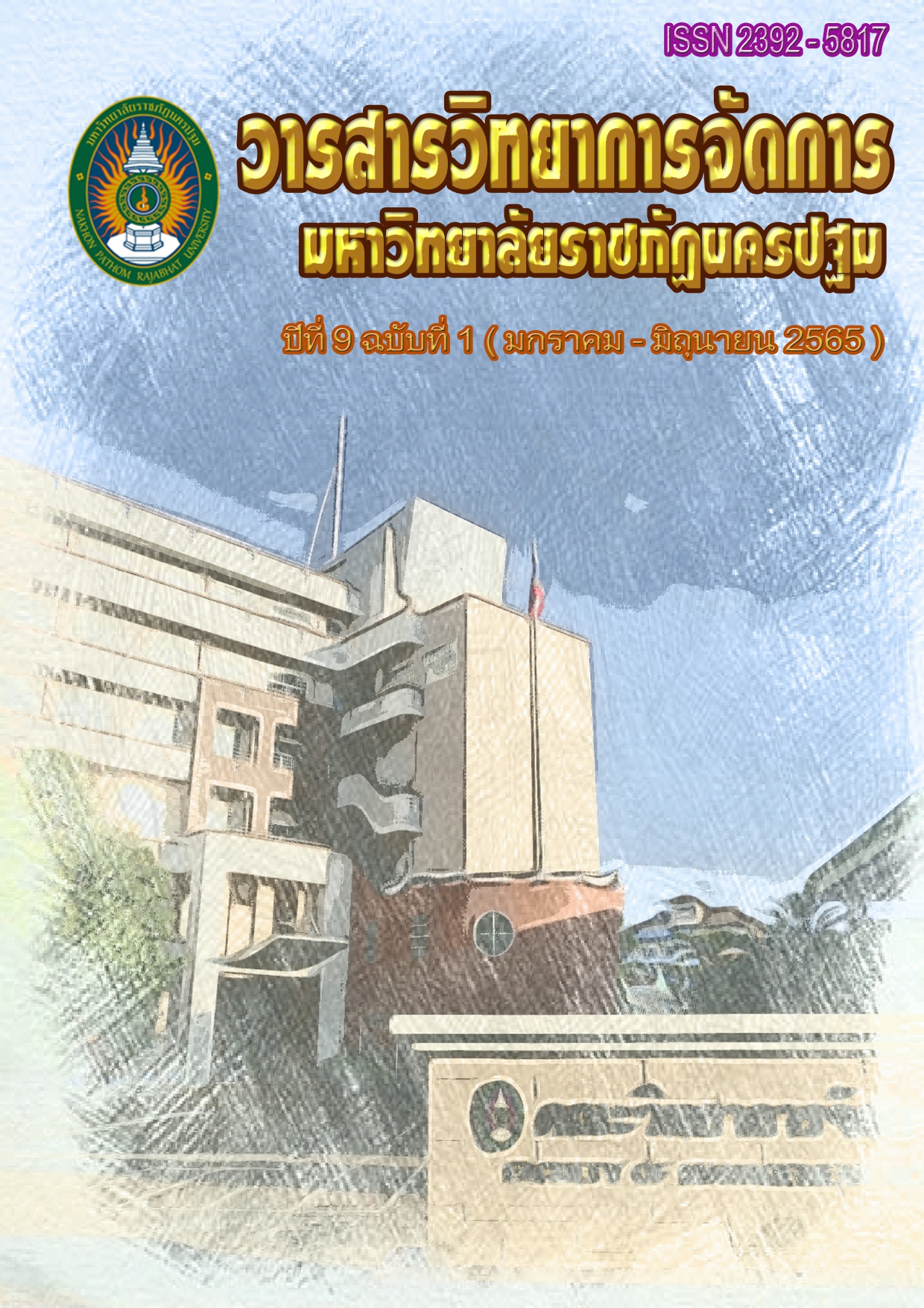Path Analysis of the Relationship of Factors Influencing Customer Engagement in the Private Hospital Business in Bangkok Area.
Main Article Content
Abstract
The objectives of this research were to study the level of factors influencing customer engagement, path analysis of the factors influencing customer engagement, and examining the consistent correlation of the factors that influence the engagement.
The sample groups were 600 patients using private hospitals where were divided by the size and number of beds into 2 groups: 101-250 beds and 250 beds or more in Bangkok area. The samples were chosen by stratified random sampling and simple random sampling, and a 5-level scale questionnaire was used. The statistics used for data analysis consisted of descriptive statistics of mean and standard deviation of each variable, Pearson's Product-moment Correlation Coefficient, and Path Analysis.
The results found that trust had the most influence sizes of 0.668, followed by Brand value, Relationship Value, and Value for Money with the influence sizes of 0.558, 0.509, and 0.323 respectively. Path analysis showed that relationship value had positively correlated with value for money. Brand value had influence sizes of 0.738 and 0.529 and negative correlation with customer trust and customer engagement with influence sizes of - 0.031 and - 0.021. Value for money had positively correlated with brand value and trust, with influence sizes of 0.173 and 0.203. In addition, value for money, brand value, and trust had positive correlation with attachment, the influence sizes were 0.090, 0.128, and 0.668, which had statistically significant at 0.01 level. The best forecasting variable equations were found that forecasting parameters of value factor (X2), brand value (X3), and customer trust (X4) could forecast customer engagement (Y) at 68%. Moreover, path analysis of the factors influencing customer engagement with the empirical data was further examined, and found that the hypothesis correlation model was consistent with the empirical data.
Article history : Received 16 April 2021
Revised 28 May 2021
Accepted 31 May 2021
SIMILARITY INDEX = 3.04 %
Article Details

This work is licensed under a Creative Commons Attribution-NonCommercial-NoDerivatives 4.0 International License.
The views and opinions of the article appearing in this journal are those of the author. It is not considered a view and responsibility of the editorial staff.
References
กรมควบคุมโรค กระทรวงสาธารณสุข. (2564). รายงานสถานการณ์โรคติดเชื้อไวรัสโคโรนา 2019. ศูนย์ปฏิบัติการภาวะฉุกเฉิน. ฉบับที่ 390.
ชาย โพธิสิตา (2556). ศาสตร์และศิลป์แห่งการวิจัยเชิงคุณภาพ. (พิมพ์ครั้งที่ 6). กรุงเทพมฯ: บริษัทอมรินทร์พริ้นติ้งแอนด์พับลิชชิ่ง จำกัด. (มหาชน).
วิจัยกรุงศรี (2563). แนวโน้มธุรกิจ/อุตสาหกรรมปี 2563-65 ใน ธุรกิจโรงพยาบาลเอกชน. [ออนไลน์]. สืบค้นเมื่อ 1 มกราคม 2563 จาก http://index.php/news-and-announce-all/news-all/180-2019-06-07-09-28-51.html. 1229-1235. 2562/T26/T26_201903.pdf
ปรียาวดี ผลอเนก. (2558). อิทธิพลของการบริหารความสัมพันธ์กับลูกค้าและความพึงพอใจของลูกค้าที่มีต่อความจงรักภักดีของลูกค้าที่มาใช้บริการโรงพยาบาลเอกชนในเขตภาคตะวันออก. วารสารครุศาสตร์อุตสาหกรรม, 14 (2). 695-702.
ศูนย์วิจัยกสิกรไทย, (2563). โรงพยาบาลเอกชน ปี’64 ... แม้รายได้กลับมาฟื้นตัว แต่ยังเป็นปีที่ท้าทายและแข่งขันรุนแรงขึ้น, กระแสทรรศน์ ฉบับที่ 3167.
สำนักงานพัฒนาวิทยาศาสตร์และเทคโนโลยีแห่งชาติ. (2562). อว. สวทช. และหน่วยงานเครือข่าย จัดประชุมคิกออฟ ‘แผนจีโนมิกส์ประเทศไทย’ หารือแนวทางวิจัยและประยุกต์ใช้แพทย์จีโนมิกส์ เพื่อคุณภาพชีวิตคนไทยที่ดี. [ออนไลน์]. สืบค้นเมื่อ 7 มิถุนายน 2562 จากhttps://sccl.mhesi.go.th
Alrubaiee, L., and Alkaa'ida, F., (2011). The mediating effect of patient satisfaction in the patients' perceptions of healthcare quality – patient trust relationship. International Journal of Marketing Studies, 3 (1). 103-127.
Brakus, J. J., Schmitt, B. H., & Zarantonello, L. (2009). Brand experience: what is it? How is it
measured? Does it affect loyalty? Journal of marketing, 73 (3). 52-68.
Gupta, A., and Sahu, G.P. (2015). Exploring relationship marketing dimensions and their effect on customer loyalty – a study of Indian mobile telecom market. International Journal Business Innovation and Research, 9 (4). 375-395.
Hatta, P.I.H. (2019). Analysis of Service Quality, Image, Promotion, Trust and Customer Loyalty. IOSR Journal of Business and Management (IOSR-JBM), 21 (1). 1-7.
Hunt, S. D., Arnett, D. B., & Madhavaram, S. (2006). The explanatory foundations of relationship marketing theory. Journal of business & industrial marketing, 21 (2). 72-87.
Kazemi, A., Abadi, H.R.D. and Kabiry, N. (2013). Analyzing the effect of customer equity on repurchase intentions. International Journal of Academic Research in Business and Social Sciences, 3 (6).78-92.
Matti, Minna, Karjaluoto, Heikki, Jayawardhena, Chanaka, Leppäniemi and Pihlström (2012). How value and trust influence loyalty in wireless telecommunications industry. Telecommunications Policy– Elsevier,36 (8). 636-649.
Naumann, K., and Bowden, J. (2015). Exploring the process of customer engagement, self-brand connections and loyalty. Problems and perspectives in management, 13 (1). 56-66.
Ramli, A. H., & Sjahruddin, H. (2015). Building patient loyalty in healthcare services. International Review of Management and Business Research, 4(2), 391-401.
Shabbir, S., Kaufmann, H.R., Ahmad, I., and Qureshi, I.M. (2010). Cause related marketing self-brand connections and loyalty. Problems and Perspectives in Management,13 (1), 56-66.
Shriedeh ,F.B., and Ghani, N.H.A. (2016). Innovation’s effect on brand equity: Insights from medical tourists. Journal of Asian Business Strategy, 6(8), 176-184.
Wu, S. I., & Li, P. C. (2011). The relationships between CRM, RQ, and CLV based on different hotel preferences. International Journal of Hospitality Management, 30(2), 262-271.


